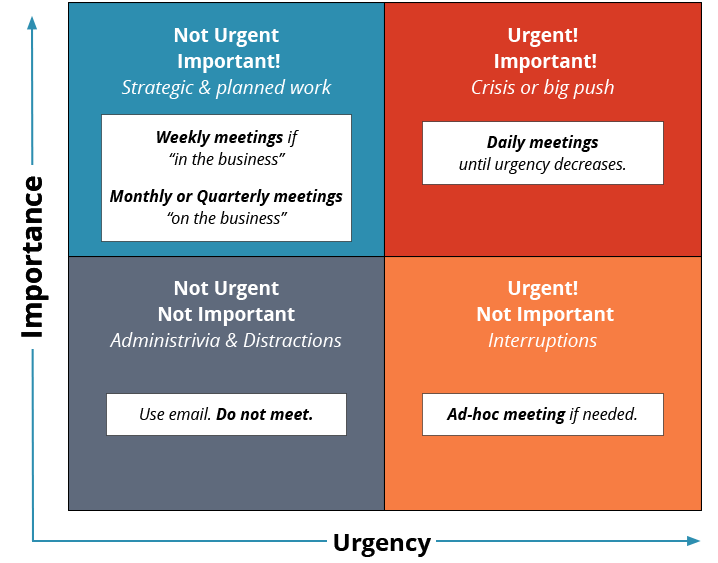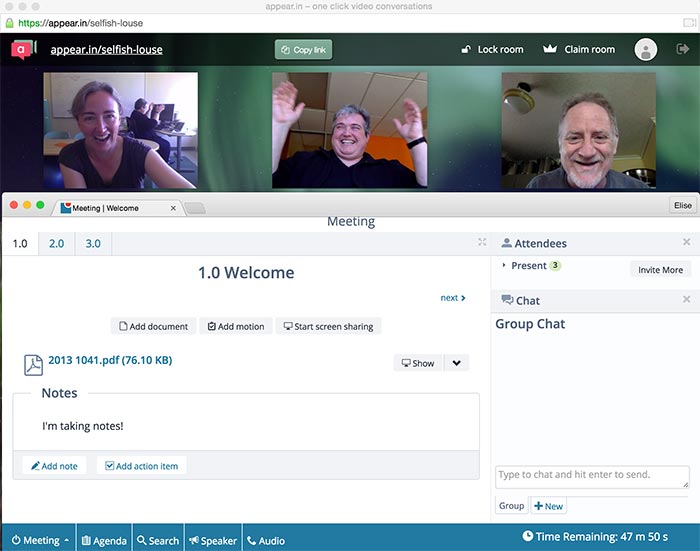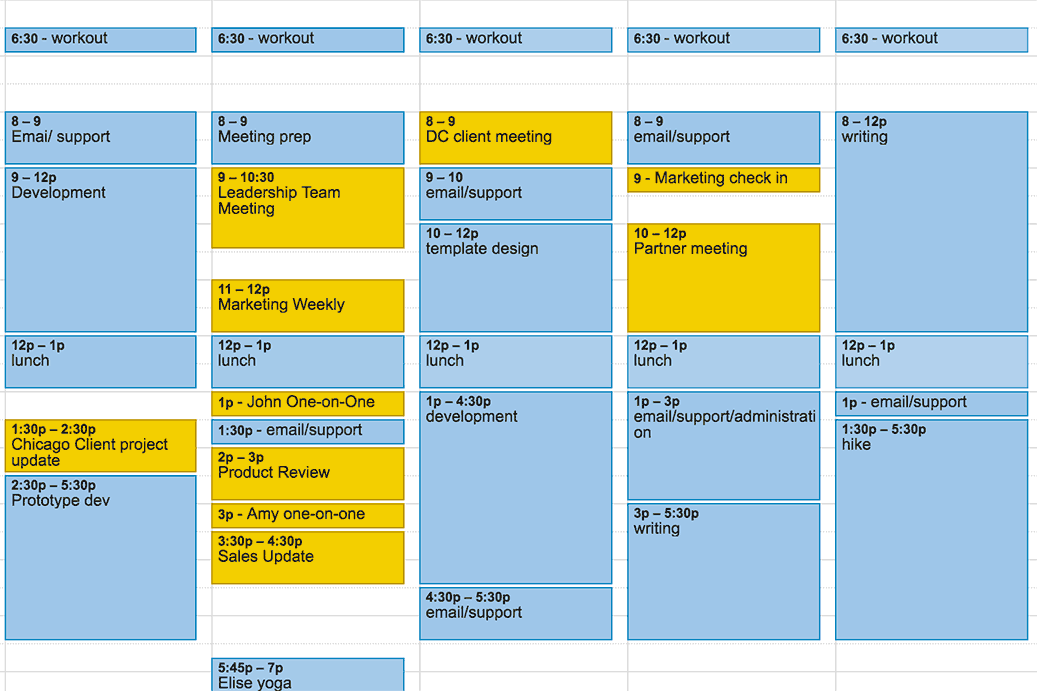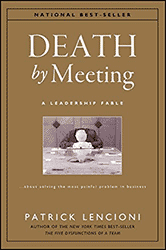How often should you meet? Selecting the right meeting cadence for your team.
What is a meeting cadence and why does it matter?
In our post about why teams meet, I outlined two basic rules:
- Meet to maintain momentum.
- Meet to change course.
Kickoffs, retrospectives, emergency meetings, planning sessions, workshops, sales, negotiations – these all fall under the definition of “changing course”.
A team’s regularly scheduled meetings should maintain work momentum and strengthen the relationships between team members. The frequency of these regular meetings sets the team’s work cadence.
We use the term cadence here very deliberately. You may find others referring to this pattern of regular meetings as the team’s meeting rhythm.
If the words cadence and rhythm bring to mind pictures of rowers at the oar, you’ve got the right idea.
A meeting cadence works very much the same way – setting a pace that keeps a group pulling together fast enough to win the race, but not so fast that they wear out before they cross the finish line.
I know, they’re rowing backwards. But now they can see their goal before them!
Getting the meeting cadence right makes a huge difference in how well a team performs.
If you go too long between meetings, work will suffer.
Over time, we’ve tried a multitude of formats for this (executive staff) meeting. Going longer than two weeks between meetings, I see the team get disconnected.
Teams that don’t meet often enough drift out of alignment, lose information, and weaken the interpersonal bonds that help them work together.
Bi-weekly meetings = waste of time
Weekly meetings = team momentum
Mike Kotsis
Founder, GPS for Small Business
That said…
Meetings always interrupt; they always prioritize time with the group over time that could be spent making individual progress.
Meet too often, and the team gets frustrated and worn down.
In the past, we tried the agile version of the 15-minute daily standup, but we found this was too frequent. Most days, team members didn’t have enough new information to convey, making a majority of the meetings not useful. The daily format also required everyone to slot some part of their day, every day to chat. That was a lot of wasteful meeting overhead.
Wade Foster
CEO Zapier
How to Find the Right Cadence for Your Team
I wish I could tell you that there was a straightforward answer here.
The question “How often should we meet?” gets asked all over the place, and the answer is usually a variation of:
It depends.
To double the challenge, I was unable to find any meaningful research on the topic. I asked researchers looking into meeting effectiveness what they knew, and while they have this great book full of fascinating studies, they had nothing when it came to finding a data-backed answer for how often a group should meet.
That leaves us with advice from consultants and the stories of those who’ve tried different cadences before they found one that worked.
Lucky for us, there’s a pretty good consensus between those who found their cadence through trial-and-error and the business consultant community.
Here’s what we know.
2021 UPDATE: While the recommendations below still mostly stand, you can see our latest info on this topic in these articles:
Recommendations for Different Kinds of Teams or Groups
This chart summarizes the recommendations we found.
Recommended Meeting Cadences for Different Teams
| Group/Meeting Type | Daily: 10 – 20 min |
Weekly: 45 – 90 min |
Bi-Weekly: 30 – 60 min |
Monthly: 2 – 3 hrs |
Quarterly: .5 – 1 day |
Annually: 1 – 2 days |
|---|---|---|---|---|---|---|
| One-on-Ones |
|
|
|
|||
| Department Staff Meetings |
|
|
|
|||
| Project Teams |
|
|
|
|
||
| Agile Teams |
|
|
|
|||
| Leadership Teams |
|
|
|
|
|
|
| Customer Success/Account Management |
|
|
||||
| All-Hands |
|
|
||||
| Boards |
|
|
|
|||
| Committees |
|
|
|
Is this too much time in meetings?
Regular meetings are a significant investment of your team’s time, so some leaders try to minimize that investment by spacing meetings farther apart, or even canceling them all together.
This can be counterproductive, because when you wait more time between meetings, those meetings need to be longer and have a greater chance of running over time.
More importantly, meetings spaced too far apart just don’t work very well.
But, for the bean counters amongst us, let’s look at the math to see how this works out.
| Meeting Cadence | Hours Per Year |
|---|---|
| 10-minute Daily | 40 |
| 15-minute Daily | 60 |
| 20-minute Daily | 80 |
| 45-minute Weekly | 37.5 |
| 60-minute Weekly | 50 |
| 90-minute Weekly | 75 |
Hours are per person assuming 240 days or 50 weeks worked per year, because you shouldn’t attend meetings when you’re on vacation or sick.
As you can see, whether you meet daily or meet weekly, you’ll spend about the same amount of time in the end.
You can also see how teams that meet both daily and weekly should be especially vigilant about keeping the daily stand-up short and the weekly meeting focused.
Regardless of the cadence you pick, most team members will spend less than 4% of their work time in this meeting.
Knowing this, you can focus on the more important question, which is:
how can you use that 4% to ensure the remaining 96% rocks?
You’ll find more details about the recommendations for different groups and lots of links to sources below.
Before we get there, though, let’s go over the high-level criteria you can use to set the meeting cadence for any team.
Criteria for Picking the Best Meeting Cadence
Like I said, how often a team should meet depends.
But it doesn’t depend on how they feel that day, or if they like meetings or hate them, or the industry they’re in, or anything like that.
The recommended meeting frequency depends on these factors:
1. Urgency & Importance
If the team pursues urgent and important goals, they need to meet often.
For example, hospital staff meet every day to ensure everyone knows the situation on the floor. Saving lives is both urgent and important, and it requires everyone to stay coordinated and informed.
By contrast, a homeowners association board will have bylaws governing when they have to meet. They rarely face an issue that they feel to be deeply important or urgent. Many HOAs must meet annually at a minimum, and they leave it at that.

2. Stability
Assuming that a sound strategic framework is in place and the leadership team is relationally mature, the leadership team can establish an effective cadence that will help it to drive the organization’s strategic intent.
Jack McGuinness
Managing Partner of Relationship Impact
Those are quite the assumptions!
Many teams do not operate within a sound strategic framework. More frequent meetings help these teams create a shared understanding of their environment so they can establish this framework.
And as for “relationally mature”? At the very least, that takes time.
New teams, teams with high turn-over, and teams with one or more…uh… relationally challenged team members also need to meet more often to bridge natural gaps in trust.
“It typically takes about 6 meetings before teams start to “get it”, and then you can relax a bit.”
Dan Prock
Facilitator, Author, Lean & Kaizen Coach
In the articles linked below, you’ll see several people say that they meet much more with a new team. Boards also ramp up their meeting cadence during times of crisis.
When the situation is unstable, teams need to put in the time to stabilize it. This means more frequent meetings.
Daily meetings help teams get through times of crisis and transition.
Alternatives to meetings


A regular meeting cadence gives teams a way to share information, raise and solve issues, and build relationships. But there are lots of ways to accomplish these same goals outside of a meeting.
Slack, Skype, email, reports, just turning around and talking with someone… there’s no need to wait until a regular meeting if you’ve got something important to share.
If your team thrives on text-based communication, you can probably meet less frequently.
If that’s you, focus more time on team building when you meet.
That said, with increasing awareness of the anxiety/addiction impact of constant communication, and the growing push to minimize distractions (like text, chat, email, etc.) to maintain work focus, these channels become unreliable.
You can’t know IF or WHEN your team will read that email or chat message.
The predictability of a regular meeting cadence lets team members plan their time to maximize productivity and minimize distractions, knowing that they’ll have an opportunity to synch up with everyone else at the scheduled time.
3. Work Function
Does your team work “in the business” or “on the business”?
Teams actively collaborating to produce a work product of some kind should meet often. Recommendations range from meeting every day to – at the very outer limits – no less than once per month.
Groups with oversight, governance, and strategic planning responsibilities meet less often. Recommendations here range from once per month – at the most – out to once per year.
There are groups that operate in both capacities.
A company’s leadership team manages day-to-day delivery and execution on the higher level strategy. No wonder leaders meet all the time!
Both functions have their own cadence, and for groups with this kind of dual responsibility, it’s important to recognize what kind of meeting you’re scheduling and plan accordingly.
4. Interdependence
How dependent are the team members on one another to accomplish their goals?
In many product development teams, each person must collaborate with several others to bring a product to market. Is the designer running behind? Problems in QA? New requirements from the client?
Any shift in timelines or expectations ripples through, impacting everyone else. This is one reason Agile, which relies on a daily meeting to keep people coordinated, has become so popular with teams like these.
By contrast, mid-level service managers and franchise owners operate largely independently.
The problems that plague a franchise in one location may have no impact on a different location. It’s useful for these professionals to meet semi-regularly to compare notes, share insights, and work to change those few things that affect them all. But that’s it.
5. Location (or Lack Thereof)
Small teams that work together in the same room don’t need to meet much.
When you all learn about changes in work environment because you were there to witness that change, you don’t necessarily need a meeting cadence.
When I was a pancake waitress, my work was very dependent on the performance of my co-workers, and always highly impacted by changes in our environment. But we never had a regular team meeting – we just watched, talked to each other, and busted out tasty pancakes.
Sorry, no. There are no pictures.
Now, I work on software with a distributed team. We have a partner currently trekking the Sahara and employees many time zones away. Today, my work is far more independent, and far more relaxed, than when I wore a pink apron every day. And yet, we meet very regularly.
There are two big risks with distributed teams:
- Out of sight, out of mind
It’s easy to get caught up in what you’re doing and forget to check in with your team members.
And the flip-side of that… - Bad assumptions
In which people either assume everything is going fine, because they haven’t seen otherwise OR, because they can’t see their team working, assume that they’re not on task.
Virtual teams can mitigate both of these risks by meeting more frequently.

The Details Behind the Recommendations
Here’s another look at our chart.
Recommended Meeting Cadences for Different Teams
| Group/Meeting Type | Daily: 10 – 20 min |
Weekly: 45 – 90 min |
Bi-Weekly: 30 – 60 min |
Monthly: 2 – 3 hrs |
Quarterly: .5 – 1 day |
Annually: 1 – 2 days |
|---|---|---|---|---|---|---|
| One-on-Ones |
|
|
|
|||
| Department Staff Meetings |
|
|
|
|||
| Project Teams |
|
|
|
|
||
| Agile Teams |
|
|
|
|||
| Leadership Teams |
|
|
|
|
|
|
| Customer Success/Account Management |
|
|
||||
| All-Hands |
|
|
||||
| Boards |
|
|
|
|||
| Committees |
|
|
|
The recommendations above are ours, synthesized from our extensive reading, work with meeting experts, conversations with customers, and the hard-won lessons of long careers.
So, you know, it’s a pretty darn informed stuff.
That doesn’t mean everyone will reach the same conclusions we have.
If there’s one thing everyone agrees about when it comes to meetings… well, I’d love to hear what that is!
To make a better informed decision when it comes to investing your team’s time, dive into the details below. For each kind of team, I’ve outlined our recommendation and then shared what other people recommend. Second opinions abound!
One-On-Ones
One-on-ones are meant to strengthen working relationships, address and resolve issues impacting an individual’s work, and to support career development.
Most experts recommend holding one-on-ones weekly, but acknowledge that this can be a scheduling challenge, which leads to lots of one-on-ones that get cancelled. So they say:
Whatever you choose, it is important to remember that the longer you go between sessions, the less timely, and less accurate, the information will be, and the less likely it is that you will be able to intervene in an issue while it is still young.
Richard Wanner
A Case for Weekly One-on-Ones
- Damon Schechter runs weekly one-on-ones with his reports, and encourages his executives to schedule one-on-ones with each other too.
Advocates for Other Cadences
-
Answers to this question on Quora range between weekly and monthly.
-
Paul Axtell, who authored two one-on-one templates for the Lucid template gallery, found weekly, bi-weekly or even monthly one-on-ones work in larger corporations
Department or Functional Group (Marketing, Sales, Finance, HR, etc)
a.k.a the Staff Meeting
Weekly meetings are the gold standard here. We agree.
Other Perspectives
- The teams at Froenetics advocates for both weekly and daily meetings.
- Hubspot’s marketing team shares tips for daily “huddles”, weekly and monthly department meetings.
- “Weekly or more” is the answer to how often sales and marketing should meet together.
- And it’s weekly again for the sales team on it’s own.
- Finance, HR, Logistics, DevOps… what about everyone else? Apparently those of you who don’t blog for a living have less to say on the matter! For you, I recommend searching for advice about “the weekly staff meeting”.
But – weekly team meetings SUCK!
The regular weekly meeting – whether it’s a department meeting, a project update, or a leadership meeting – is one of the worst run, most poorly planned, and deeply despised of all meetings.
Our consulting team hears complaints about the weekly meeting all the time.
We’ve even given it a nickname: The Dreaded Wednesday Meeting.
Yet the recommendation stands.
If you want to maintain work momentum, you need a weekly team meeting.
A study of managers in the workplace found that:
Managers who were deliberately redundant moved their projects forward faster and more smoothly.
Professors Tsedal Neely of Harvard and Paul Leonardi of Northwestern, on HBR.com
A well-designed regular meeting agenda proves the perfect vehicle for repetitively, redundantly, and usefully emphasizing what matters most for your team’s success.
“Well designed” is the key. We’ll look at how to design your own agenda in the next part of this series, but in the interim, browse our templates for some great examples.
Project Teams
How often should your project team meet?
It really depends.
This was the one place where a strong recommendation was hard to make, for several reasons.
- Project teams have several kinds of regular meetings.
Internal project team meetings usually happen more frequently than updates with clients and other stakeholders. - The recommended meeting frequency depends more on urgency and importance than for other kinds of team meetings.
A team on an urgent one-month project should meet daily, while a team on a multi-year project may only need to meet once every few weeks or even once per month.
Additional Resources
- Lynda.com: How often should I have progress meetings?
- From Project Connections
- From BrightHub
Our recommendation:
When in doubt, project teams should meet weekly.
And for those projects that move really fast, consider checking out…
Agile Team Meetings – err, Ceremonies
If you work on a team that’s adopted an agile methodology (Scrum, Kanban, XP or the like), then you already know the recommendations here.
Agile teams hold very short daily meetings to ensure issues get uncovered as quickly as possible.
Agile teams also meet at the start and end of every iteration, which often means at least two longer meetings every few weeks. The cadence for these longer meetings depends on the length of each iteration.
Atlassian has a nice short post that describes regular agile team meetings.
Software teams are the most likely groups to use an agile methodology, but there’s no rule saying only software folks can run stand-ups. If you have a group that works really fast and has trouble keeping it all together – or if you have a group that should be moving faster – an agile meeting cadence may improve the situation.
Related: Debunking 4 Common Myths about Agile Stand-Ups
Leadership Teams
A healthy, productive leadership meeting cadence can make the difference between an organization that struggles to survive and an organization that thrives and grows.
And while we don’t have research on how often teams should meet, there’s a ton of research on leadership effectiveness.
We know that how leaders make and discuss decisions, how well they coordinate across departments, and how adept they are at identifying and solving problems will have a massive impact on the organizations they lead.
There are two categories of leadership team meetings.
- Daily and/or weekly meetings to share information and solve detailed problems
- Monthly, quarterly and annual strategic meetings
Every recommendation we found agreed that leadership teams must hold these regular meetings to be effective:
- An annual meeting to set the overall strategy
- A quarterly meeting to adjust strategic plans as needed
- A weekly meeting to review performance and solve problems
Others also recommend a daily leadership huddle and a monthly strategic check-in. An all-you-can-eat buffet of meetings!
At Lucid, we follow the core recommendations in bold above.
We meet every week using the same agenda to monitor and manage our day-to-day operations. We meet quarterly (well, usually) to adjust strategy. And we update our strategic plan at the beginning of every year.
Because getting the cadence right is so critical to leadership team performance, the expert consultants don’t leave this to chance. They spell out not just how often teams should meet, but exactly how long each meeting should last and the agenda to use.
Here are some examples.
Recommended Leadership Team Cadences from Popular Strategic Frameworks
Patrick Leoncini, author of Death by Meeting and The Five Dysfunctions of a Team, and his firm The Table Group, prescribe this meeting cadence.
- A daily check-in to share schedules and activities
- A weekly tactical meeting to review weekly activities, resolve tactical obstacles and issues
- A monthly strategic (or ad-hoc strategic) meeting to address critical issues affecting long term success
- A quarterly off-site to review strategy, competitive landscape, industry trends, key personnel, and team development
Verne Harnish and his firm Gazelles consult with high-growth companies working to scale without imploding. They outline what they call the “Rockefeller Habits”, which includes this meeting cadence.
- 7-12 minute daily “adrenaline” huddles
- 60-90 minute weekly operational and tactical review
- .5-1 day quarterly review and group education session
- 2 day annual planning
Quick note: I’ve seen testimonials from people who’ve adopted this cadence. They say the daily huddles have revolutionized their work – in a good way. So while a daily meeting may be too much for some teams (ours included), it could be just right for yours.
Geno Wickman lays out a clear meeting cadence as part of his team’s Enterpreneur’s Operating System. I think the Level 10 Weekly meeting is particularly well designed. Their cadence:
- 90 minute weekly operational meeting, aka The Level 10 Meeting
- 1 day quarterly strategic reconnect and adjustment
- 2 day annual strategic planning
Jack McGuinness, Managing Partner of Relationship Impact, recommends this cadence.
- 1 hour weekly meeting to track and monitor execution
- 2-3 hour monthly meetings to correct deviations
- 1 day quarterly meetings to review results and adjust strategy
- 2-3 day annual meetings to set targets
Level Up! Company-Wide Time Blocking
Are you exhausted by the prospect of all these daily, weekly and quarterly meetings yet? Wondering how you’re going to get anything else done with all these meetings in the way?
Yes, you need to have regular meetings. But that doesn’t mean they should be allowed to pop randomly across your calendar like bad acne.
As a leadership team, consider using time blocking to keep meetings productive and minimize disruption to the rest of the work week.
I love ♥♥♥ time blocking as a personal productivity tool, and find the idea of applying it to a whole team or company terribly exciting.
Apparently I’m not alone. You can read more about this at the end of Forbe’s profile of Jack Dorsey
How it Works
- All weekly meetings, for all departments and projects, happen on the same day. This means people attend several meetings that day, getting into “meeting mode”. Tuesdays are a popular choice for Meeting Day.
- One day a week is designated as “No Meetings” day.
Everyone can plan to spend the full day focused on completing her or his part of the work. - Theme other days as appropriate.

Research shows we take an average of 25 minutes to get back on task when we’re interrupted, and meetings are always an interruption – unless that’s the main focus for the day!
A designated meeting day makes it easier to embrace the work required to make those meetings productive. And planning to spend your day in meetings is a lot easier when you know you’ll have a day without any meetings soon.
Client Account Management and Customer Success
Account representatives act as the “board” in charge of overseeing the company’s relationship with a client. Like all higher-level “on the business” functions, account managers use a more infrequent meeting cadence.
When a client seems happy, account managers schedule meetings quarterly to ensure the relationship stays strong. This meeting cadence is known as the QBR: Quarterly Business Review.
If there is a contract to renew, that will be the main topic at one of these quarterly meetings.
More on the QBR
When an account is in trouble, a good account manager will ramp up the meeting cadence.
After getting the right people involved to work on a customer’s issue, the account manager schedules bi-weekly check-ins designed to repair the client relationship.
Interestingly, it is only in situations like these that we recommend a bi-weekly cadence.
What about bi-weekly meetings?
Time and time again, we read about people who tried switching their team meeting cadence to every other week, hoping to cut back on the amount of time wasted in meetings, and then went back to weekly meetings soon thereafter.
We tried this ourselves in the past, and saw a disheartening drop in team productivity.
Bi-weekly meetings are too far apart for most teams actively doing the work.
We saw 3 situations where bi-weekly meetings succeeded:
- Account managers working to improve a rocky client relationship
- One-on-ones in a stable team
- Project updates to external stakeholders on a long-term project
In each case, the bi-weekly meeting is designed to improve a working relationship.
For example, a successful bi-weekly project update focuses less on specific details and more on building stakeholder trust, giving everyone just enough visibility to feel confident about the project’s success.
If you need to repair or maintain a relationship, but don’t need to work through decisions and details, consider a bi-weekly cadence.
In most other cases, bi-weekly doesn’t work.
All Hands
How often should you meet with the whole company?
All-hands meetings are expensive, hard to coordinate, and often uni-directional, giving those attending little opportunity to participate.
For larger, established companies, it’s sufficient to have an all-hands meeting every 6 months or so.
This is also the recommended cadence for company retreats in distributed companies. If your workforce is highly distributed, getting them all together every 6 to 8 months significantly improves working relationships and accelerates productivity.
Smaller companies hold all-hands meetings quarterly.
Quarterly all-hands meetings often line up with the quarterly board meeting schedule. This gives leadership a chance to share the same insights and performance information with employees that the board sees, and to communicate any new board resolutions that impact everyone.
In very small or new companies, there’s no difference between an all-hands meeting and a “staff” meeting.
New companies may gather everyone to meet every week. While technically this is an “all-hands”, there really aren’t that many hands involved, and the guidance for department meetings applies.
Additional Resources
- On Entrepeneur and again
- On Quora
- From Clear HR Consulting
Boards
We already talked about how mostly volunteer boards such as HOA boards, with mandatory meeting requirements but no other real pressing business, can meet as infrequently as once per year.
Setting those aside, the most frequently recommended cadence for board meetings at stable organizations is quarterly.
Quarterly meetings (so 4 meetings per year), with the major focus of each meeting planned in advance, give boards at stable organizations enough time to complete their duties.
A cadence like this can work, but it increases the importance of communication between meetings. For a board that only meets 3 or 4 times a year to be effective, you need to ensure information gets to the board members between meetings, so meeting time can be reserved for discussion and decision making.
Many boards meet more frequently.
Volunteer boards in organizations where the “board” and the “organization” are pretty much the same thing, such as Parent Teacher Associations and the like, meet every month.
Boards for companies in transition – newly founded companies, and those facing acquisition, merger, a major leadership shakeup, financial emergencies, legal trouble, etc. – will also meet much more frequently.
Additional Resources
- Brad Feld feels startup boards should meet 8 to 12 times per year at the beginning, then 6 times per year as they mature.
- Dani Robbins at Nonprofit Evolution prefers monthly meetings for Boards.
- Boardworks International and Early Stage Tech Boards also advocate for an initial series of monthly meetings that later transition to quarterly.
Committees
Last but not least, the committee meeting.
The best way to determine the right cadence for your committee meeting is by checking the committee’s charter.
If the committee is temporary, with a single task to complete before it disbands (a nominating committee, for example), then meetings should be scheduled the same as they would be for a project team.
If the committee has a long-term governance mission, like a technical standards committee for example, then meetings should be scheduled more like board meetings.
Whether using a production cadence or a governance cadence, committee meetings should always be scheduled with the board meeting dates in mind.
Schedule committee meetings so they can complete their business before the board meets.
More Advice
- BoardPad offers these Tips for Effective Board and Committee Meeting Scheduling.
- This advice for Health and Safety Committees recommends scheduling committee meetings to coincide with inspections. Clearly specific to this situation, but good advice that has parallels for many other committees.
In Summary
Now after all that, we’re back where we started. The answer to the question “How often should my team meet?” remains “It depends.”
Does your team do the work, or do they plan and oversee the work? Is it more important for you to wrangle details, or to build trust? If you miss a meeting or two, how well can you predict what happened in your absence?
All of this nuance can be frustrating. There is no right answer for everyone.
There’s not even a guarantee that the right answer you work so hard to find today will stay the right answer tomorrow.
Please resist the temptation to oversimplify this one.
In the charts and examples above, you’ve seen clear guidelines and strong recommendations.
- Most teams work best when they establish an effective meeting cadence.
- A cadence that’s too fast or too slow proves counterproductive.
Channel your inner Goldilocks and work to get this just right. - Teams actively working to produce something should meet frequently; daily or weekly meetings often work best. Also – time blocking! Soo cool.
- Teams working “on the business” should meet infrequently; monthly or quarterly work well.
To run effective meetings, we must embrace this complexity.
Cadence is just one part of the picture. Teams need to meet regularly, but more importantly, they need to be running the right meeting.
Next time, we’ll dive into meeting design.
We’ll talk about which meetings to design, go beyond basic frameworks, and explore different ways to help teams thrive. We’ll also share the worksheet we use to design meetings for the Lucid gallery.
In the interim, please share your thoughts. If you have a perspective that adds to or contradicts anything here, we’d love to hear it. Examples, feedback, questions and criticisms welcome!
This is the fourth post in a six-part series exploring what it takes for companies to run consistently worthwhile meetings.
- Introduction: Creating A Foundation for Changing Your Organization’s Meetings
- Meeting Strategy: Why meet? Understanding the Function of Meetings in the Collaborative Workplace
- Meeting Execution: The Underlying Structure of Meetings that Work
- This post! Meeting Cadence: How often should you meet? Selecting the right meeting cadence for your team
- Meeting Design: How to Create Standard Agendas for Your Business
- Meeting Performance Maturity: How to evolve meeting performance across the organization






